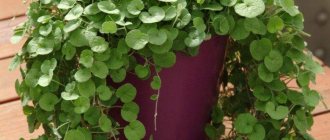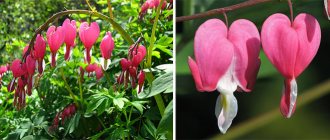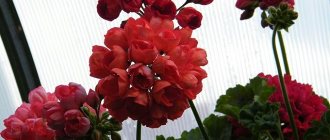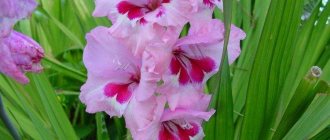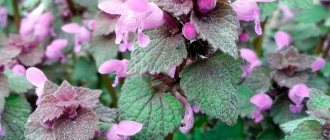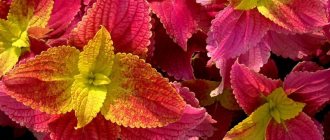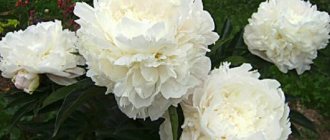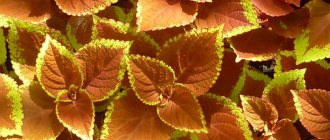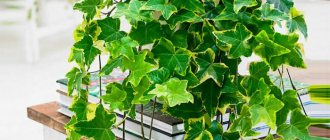Coleus is a plant of the Lamiaceae family; people also call it “nettle” because of its external similarity. The leaves are heart-shaped and vary in color; they can combine several shades at the same time: green, burgundy, yellow, red. There are a large number of its varieties (more than 1000), the most common are Blume, Black Dragon, Hybrid, Wizard. When purchasing a plant in a store, you need to pay attention to the presence of shoots, there must be more than one, as well as the absence of a flower, otherwise problems may arise in their maintenance.
Conditions for growing coleus at home
The table shows the basic requirements necessary for flower growth.
| Indicators | Description |
| Lighting | Avoid direct sunlight; in summer it is better to take it outside (balcony). |
| Optimal temperature | In summer +18 °C, in winter +12 °C. |
| Watering | Spring-autumn - abundant, lukewarm water, while it is necessary to control the dryness of the top layer in the pot. In winter – moderate, do not allow the soil to dry out. |
| Humidity | High, constant spraying of leaves is required. In winter, the ideal place for the plant is the kitchen, where conditions are best during this period. |
| Priming | Unpretentious, any soil mixture will do; minerals are added as needed. |
With a lack of light, the plant begins to grow rapidly upward and lose foliage, and its excess leads to stunting and loss of color saturation. Therefore, it is very important to ensure that the light is supplied correctly. The temperature regime is also important - the flower reacts very sharply to its changes. The nitrogen content in the soil helps to increase color saturation.
You can increase the humidity by placing a reservoir filled with wet expanded clay next to the pot.
Red nettle home flower. Coleus flower - house nettle
The beautifully named genus Yasnotkova has more than 150 species, one of which is coleus.
For the shape and texture of the leaves, it received the nickname “nettle”, and for its similar color it is called “poor man’s croton”, because in the beauty of natural patterns it is in no way inferior to croton, but in cost it is significantly ahead of it. So, in addition to attractive colors and an abundance of varieties, coleus can boast a favorable price! Coleus is a tropical flower; it came to us from the forests of Asia and Africa, where it is used not only for decorative landscaping, but also for food. But you shouldn’t follow the example of the aborigines, because we have hybrid varieties growing on window sills, in gardens and indoors, which you can only admire. In nature, coleus are shrubs or subshrubs, 30-50 cm high, whose structure resembles the familiar nettle.
These representatives of the floral world amaze the imagination with a variety of shades and patterns. In terms of beauty, they can give odds to any variegated plant! They can have bright green, brown, purple, yellow, cream, red, burgundy, pink foliage, as well as mixtures of colors to form a unique pattern. The velvety leaves of coleus often have a contrasting edging; they may have dots, stripes, stains, large or small speckles, and a marble pattern. All this gives the flower an extraordinary exoticism!
Do you know that... The closest relatives of homemade nettle are mint, basil, oregano and other spicy aromatic herbs. Although the coleus itself has no smell at all!
By the way, coleus is a flowering plant, but despite all its leafy beauty, its flowering is not particularly decorative. Usually the plant produces an arrow with small white or bluish flowers, like Fittonia.
Gardeners value the Renelta variety (Coleus rehneltianus), which has matte red foliage with green or cream edging.
K. rehneltianus
Coleus pumilus is used as a hanging plant; its lodging stems can be shaped and guided to form a lush bush.
K. pumilus
Bloom's Coleus (Coleus blumei) is a derivative of the Scutellarioides variety, from which countless species with a full palette of colors have been bred. The botanist Carl Blum gave it his name; it was he who developed this variety.
If desired, you can create your own colorful composition by combining different types.
Coleus transplant
This process occurs in the spring after pinching. The acidity of the prepared soil should be within 6-7 pH. However, it does not need to be moved repeatedly because its root system is poorly developed.
The plant is considered an annual, but if certain conditions are met, it can grow for more than one year, you just need to periodically change the soil, and if the pot becomes small, then replant it. In this case, it is necessary to carefully examine the roots for the presence of bad ones (rotten or dead), and, if possible, remove as much old soil as possible.
Pests and diseases
Most often, the stimulus for the appearance of diseases and pests is a decrease or temperature difference. Then it can be affected by fungus, whiteflies, scale insects, mealybugs, and spider mites. They quickly appear on weakened plants.
If pests are detected, the flower should be treated with a biological control agent. It is important to use gloves and a respirator. Make sure that the drug does not fall into the hands of children or pets! This is poison!
Coleus pruning
The flower should be subjected to this procedure systematically. The following reasons for its implementation can be identified:
- better formation of branching, subsequently leading to the creation of a large bush (produced half a month after the dive);
- planting by cuttings (cut off older sprouts);
- reduction in growth (the top is cut off, thereby forcing it to grow in width rather than in height, giving the plant splendor);
- planned pruning (done on flowers older than a year, all shoots are cut off, leaving only 2-3 shoots);
- giving shape, decorating (cut from a formed bush).
Caring for coleus in the garden
Caring for coleus involves abundant watering (especially in hot weather and drought) with settled tap water or rainwater in the evening or morning. The soil should not dry out. When watering, make sure that moisture does not get on the shoots and leaves. Periodically loosen the ground and weed out weeds.
https://www.youtube.com/watch?v=d44zCvI-26k
After two weeks, fertilizers are applied to the flowers, halving the dosage indicated in the instructions. In the active growth phase, feed with nitrophoska once every seven days, then with a solution of wood ash. Next, mineral and organic fertilizers are used. This makes the leaves decorative and slows down flowering.
Formed inflorescences are removed so that the bush does not waste nutrients on their development. Pinch when the flower reaches 10-12 cm and trim 2-3 times per season. At a height of 4-5 cm, the buds on top and side shoots are removed, then the flower will take the shape of a ball. Bushes that are too tall and heavy are strengthened with supports.
Coleus (indoor and outdoor) does not tolerate sharp drops in temperature; its growth slows down in cold summers.
Coleus propagation
This process is very easy, their germination rate is 100%. In order to avoid loss of the delicacy of the leaves, it is propagated by seeds (picking) and cuttings (vegetative method).
Sowing seeds, small in size, occurs in the spring in small clay cups (bowls), placing a pre-prepared peat substrate on the bottom and sprinkling a little sand on top. The first sprouts will appear only after two weeks, after which they are transplanted into small boxes with an interval of 2x2 cm, and the soil must be combined: leaf, peat, turf, sand.
It is advisable to include a drainage layer (you can use small expanded clay or small pieces of broken brick) to avoid water stagnation.
After the formation of 1-2 leaves, the plant is transplanted one at a time into pots 7 cm high, and the composition of the soil does not change. Then, after a month, it is moved to larger pots (9-11 cm). In order to increase the number of branches on the coleus, pinching is done, that is, pruning the apical shoots. After just six months, the grown shoots can be used to decorate a room or flower bed.
Cuttings begin at the end of winter (February) and end in May. A specially separated part, approximately 10 cm long, is placed in distribution boxes. The appearance of roots is observed already on 8-12 days. After which it is moved into a pot 9 cm high. This method is the easiest and most reliable, however, when planting seeds, the number of seedlings will be larger.
Maintenance of the plant requires timely watering and high-quality lighting.
Decorative garden nettle. Signs associated with coleus
According to ancient legend, coleus brings wealth and good luck to businessmen. Therefore, it is recommended that large companies have it in every office. This plant acts on the subconscious of people, forcing them to think correctly and fruitfully. Managers who have nettles in their office solve complex problems with ease and are able to react quickly in extreme situations. They are able to solve any problem to their benefit.
But in the house it is better to keep this plant in the living room, kitchen or hallway, since coleus does not allow a person to relax, and its presence in the bedroom can greatly irritate the owners of the house. Some people believe that nettle is generally dangerous and should not be kept in the house, but this is just speculation related to the name of the plant. Nettle stings, so coleus (nettle), in the opinion of a person, can have a negative effect on the energy of a home.
Also, its reddish tint is associated with negativity and it is believed that this plant can lead to a fire in the house. In fact, many Russian families have this plant on their windowsill, and no troubles come into this house. So you need to believe only in good omens and keep those plants that truly please the eye and appeal to you.
Whether it is superstition or not is up to you to decide. But there is one large company that really believes in omens regarding coleus, and even named itself after this plant. She produces wonderful mattresses that are a pleasure to sleep on. This company exists successfully in the market and has a good income. Employees of this organization believe that luck accompanies their company due to its name.
Problems when growing coleus
When maintaining the plant, minor difficulties may arise, which are listed in the table.
| Problems | Causes |
| Slow growth. | Lack of useful fertilizers. |
| Loss of foliage. | Low temperature, draft. |
| Faded leaves. | Lack of light. |
| Rotting of the stem from below. | Lack of drainage layer in the soil. |
| The tips of the leaves turn brown. | Insufficient air humidity, poor watering. |
| Spots appeared. | Exposure to direct sunlight. |
| Curling of leaves. | Infestation with parasites. |
The plant is not considered poisonous and is safe even if swallowed. Damage can be caused by insects: aphids, whiteflies, spider mites, scale insects. They appear when the indoor air is very dry. If pests are detected, the affected areas are cut off, and the flower itself is treated with an insecticide.
Houseplants. Poisonous indoor flowers and plants photos and names
This section of the catalog of indoor flowers and plants contains some household crops that are distinguished by their beauty combined with toxicity. To learn more about the representatives of the flora, their photographs and names, read our entire article.
Cyclamen
People are sure that cyclamen drives away fears and bad dreams. It is often placed at the head of the bed. It is worth immediately noting that the flower is poisonous. Sometimes you come across information that the juice of the plant’s root is dripped into the nose to treat sinusitis - this is a terrible mistake. The temperature may rise, the mucous membranes may burn, the throat may become sore, and breathing may become difficult. Toxic parts of the flower: root system, seeds, juice, causing decay, irritation of the dermis.
Amaryllis beauty
The houseplant has toxic bulbs. They contain galantisine alkaloid. In a small dosage, lycorin provokes expectoration, in a large dose it provokes vomiting. If a plant leaf bursts and releases juice, you need to treat your hands and do not rub your eyes.
Dieffenbachia
An indoor flower can improve the air in a room. However, it cannot be placed in bedrooms. The plant sap is toxic, especially the stem sap. It provokes breathing problems, the digestion process, and provokes burns on the dermis. If there are flowers in the house, it is best to take care of it with gloves.
Geranium
The plant is naturally beneficial. On the one hand, geranium acts as a disinfectant, relieves tension, pain from sore throat, and otitis media. But there are people who suffer from allergic reactions after smelling the smell of geranium. Also, homemade flower is extremely dangerous for pregnant women, young children, people suffering from low blood sugar and taking contraceptives.
cacti
The plants are not toxic, but only dangerous with their thorns. For example, the trichocereus cactus contains psychotropics, can cause paralysis of the central nervous system, its effect is similar to that of a semi-synthetic psychoactive substance from the lysergamide family.
Rhododendron
Another name for the indoor flower is “azalea”. The plant is picturesque, has lush whitish, pink, red inflorescences. Only leaves that contain a toxic substance, a glycoside, that causes poisoning, are toxic in indoor flowers. Azalea should not be kept in the bedroom. Place flowerpots with plants in places protected from “little brothers” and children.
Ivy
A shrub similar to a liana. Belongs to the Araliaceae family. The leaves are dark green with a carved border, the stems are long and curved. The flower has toxic berries and leaves if ingested by the human body. Cats are particularly affected by ivy. They are attracted by the luscious greenery of the crop.
Croton
Belongs to the Euphorbiaceae family. One of the famous, widespread flowers among gardeners due to its large leaves of unusual colors. The plant is toxic because of its seeds and juice. A toxic liquid appears when the leaves and stem are damaged.
Spurge
Widespread indoor flower. Euphorbia looks like a small palm tree: dense green leaves are placed in a bunch at the top of a thick stem. The seeds and juice of the crop are poisonous. During transplantation, all precautions should be taken.
Brunfeelsia
The plant grows in Europe and the USA. Belongs to the nightshade family. It smells great and blooms with bright lilac inflorescences.
All parts of the crop are poisonous. Particularly a lot of poison is contained in the seeds and fruits.
Mr. Summer Resident advises: useful actions when growing coleus
By following a number of simple recommendations, the plant will not cause difficulties in care:
- The best place for it is a window sill on the east or west side.
- It is necessary to hide the plant from direct exposure to the sun. The following pattern is observed: the more light it receives, the more leaves it acquires.
- The ideal water for irrigation is settled and at room temperature.
- In winter, it is better to place the flower away from radiators; a good solution would be to move it to the kitchen. If the room temperature is high, then the number of waterings should be increased.
- If there is no water in the pot for a long time, the coleus will dry out, but it can be quickly brought back to life by abundant watering and spraying.
- It will look great among monochromatic plants.
- When planting it, you must be guided by the time of its maturation - to obtain a flower of bright, rich color it takes approximately 5 months.
- It is very sensitive to overwatering, so you need to be especially careful when watering it.
Coleus is an unpretentious indoor flower, which makes its care at home as convenient as possible and does not cause any particular difficulties.
Popular questions and answers
We talked about coleus with agronomist-breeder Svetlana Mikhailova - we asked her the most popular questions from amateur gardeners.
How to choose coleus?
When buying coleus, pay attention to its appearance: the leaves should be bright and elastic. If possible, remove the plant from the pot with a lump of earth and inspect the roots. Ideally, they are well entwined and have no signs of rotting.
What should be the pot for coleus?
Pots with a diameter of 9 cm are suitable for young plants and rooted cuttings. For adults - about 20 cm. Coleus look good in clay slides, but in this case they will have to be watered much more often.
Is it possible to grow coleus outdoors?
Can. And even necessary - in the open air they grow much better and look brighter. It is generally recommended to take them out onto the balcony in the summer. But you can also plant it in the garden - at the end of May, when the threat of spring frosts has passed. And in the fall, the plants can be dug up and planted again in the hills. Or cut and root the cuttings and leave the old coleus in the garden.
When and how to take coleus cuttings
In fact, you can cut coleus throughout the year, but, naturally, in spring and summer this percentage is much higher for objective reasons (longer daylight hours, more comfortable air temperature).
Cuttings for rooting are cut only from the tops of healthy shoots that have at least two fully formed leaves.
The length of the cutting, preferably, should not be less than 10 cm, and a cut on a young plant can be easily made with a pre-disinfected sharp knife, blade or scalpel. Scissors are not suitable for these purposes, as when cutting they crumple and deform the plant stem.
If cuttings are taken in winter from coleus growing in a room, then additional artificial lighting is necessary for their rooting.
General information
The leaves and stems of the plant resemble nettles. Many gardeners say that it resembles croton, but its appearance is not so noble.
Coleus is quite easy to care for and grow at home, which is why it is loved by both gardeners and indoor plant lovers.
Necessary conditions for favorable growth:
- The right location
- Timely watering
- Top dressing
- Crown formation
The spectacular foliage and variety of species of this plant attract flower growers and florists.
Description of the plant
The flower has a tetrahedral stem. Its leaves are oval-shaped with a variety of edges: jagged, wavy and curly edges. Green, red, purple, brown colors. The flowers are paniculate inflorescences, blue, white, yellowish.
Coleus species
Varieties, when grown indoors or outdoors, reach more than 150 species. All varieties differ from each other in color, texture and size of leaves.
The most popular species is Coleus hybridus (Coleus hibridus)
This is not a tall bush, native to Sri Lanka, reaching a height of 0.5 m.
Depending on where it is grown, the leaves will have different colors. In the shade, the veins of the leaf will be green, and in a sunny location they will be red, brown, burgundy, and yellow.
Leaf blades may have carved and corrugated edges.
Blooms with small blue inflorescences.
Coleus Blume (Plectranthus scutellarioides)
A tall bush of the Lamiaceae family. Its homeland is the Southeast forest of Africa and Asia.
The unusual combination of leaf colors of green with dark purple, yellow with red, salad with creamy white is very popular among gardeners for landscape design and among indoor plant lovers.
The variety of colors depends on the variety.
The leaves are velvety to the touch. Arranged in pairs, crosswise.
Popular varieties of Coleus Blume
| Variety | Description |
| Magic jade | White core, lettuce edge |
| Coral | The coral center is framed by a brown-golden outline |
| Velveteen | Dark red sheet with a light stripe, carved outline |
| Black dragon | Brown-purple leaf with scarlet veins |
| Wizard | Various shades |


